Solar Powers Distant Hill
“Be like the flower, turn your faces to the sun.” Kahlil Gibran
At Distant Hill Gardens, we pride ourselves on working with Nature, not against her. There is no better way to build this relationship than to accept the energy that Nature offers us every sunny day. We are following the advice of Thomas Edison:
"I'll put my money on the sun and solar energy. What a source of power"
Our Passive Solar Home
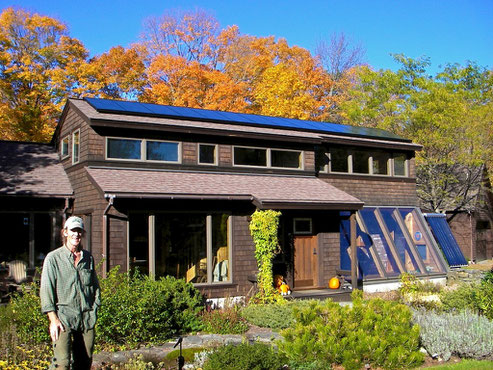
We began building our passive solar home in the summer of 1979. It went through a number of changes and renovations over the years, with the last major construction in 1995. The 1800- square foot home is heated with a combination of solar energy that enters through 250 square feet of south facing glass, and two cords of wood. A conventional home, with the same amount of insulation, would need roughly double that amount of wood for a heating season.
Our Solar Powered Furnace
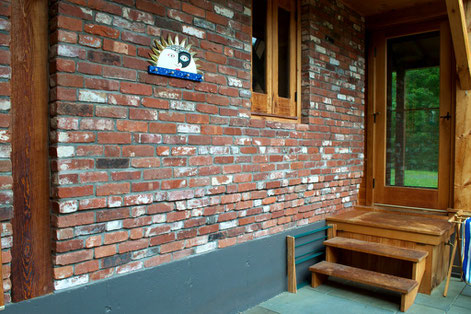
The heart of the solar heating system for our home is the foot thick brick and concrete wall at the rear of the sixteen-foot long sunspace or 'solar furnace'. This large amount of concrete and brick adds the thermal mass needed for a passive solar home to function efficiently. The wall acts like a large radiator and the sunspace like a hot air furnace. The sun's rays coming through the sloped glass heat up the mass wall, and the stored warmth is radiated back out into the house at night. The sun also heats the air in the sunspace, which is moved automatically into the living space by a thermostatically controlled fan.
The sunspace also doubles as a solar clothes dryer (you can see two of our wooden clothes racks in the photo), and a greenhouse for starting vegetable transplants in the spring. But my favorite use of the sunspace comes when we hang up our hammock on a cold winter day. On a sunny 0℉ (-18℃) winter day, our 'solar furnace' sunspace will be 80℉ (26℃) or more!
Our Solar Hot Water Heater
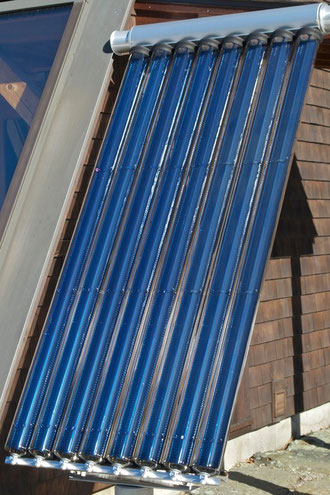
Our solar hot water heating system was installed in the autumn of 2008. It consists of a ground mounted 8 tube Sunda Solar Seido-1 series evacuated tube solar hot water collector at a 60 degree angle, a pressurized closed loop antifreeze filled system, a pump station with a built in heat exchanger, a super insulated 50 gallon hot water storage tank, and a conventional 35 gallon electric hot water heater. We estimate it provides about 50% of our hot water needs.
We chose to install a solar hot water heater before a photovoltaic system because it was much less expensive. It turned out we made the right decision because a large State on New Hampshire rebate became available in 2009 for PV systems. So, along with federal income tax incentives available for solar, the rebate made the installation of the PV array financially possible.
Our Photovoltaic System
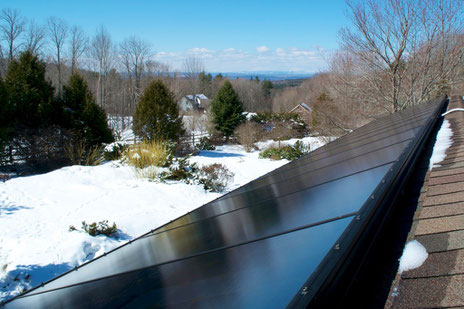
In April of 2009, we installed a 3.15 kW photovoltaic system on the south facing roof of the house. The 14 SunPower Signature™ black solar panels supply about 75% of our yearly electric needs. The array is wired directly to the grid, using a payment system called
Net Metering. In a net metering program, the electric company allows a customer's meter to actually run backwards if the electricity the customer generates is more than they are consuming. At the end of the billing period, the customer only pays for their net consumption: the amount of electricity consumed, minus the amount of electricity generated.
We installed another 4 kW 16 panel photovoltaic array in September 2016 on an outbuilding near our house, and have begun replacing our gas powered equipment with battery powered equipment. We now have a battery-powered weed wacker, pole pruner, leaf blower, lawn mower, pruning saw, and chainsaw. Most of the landscape maintenance, and even the cutting of the cordwood to our heat the house, is now powered by the sun!
Other Solar Components
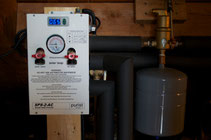
The 'Purist' brand pump station for the solar hot water heater has an internal heat exchanger.
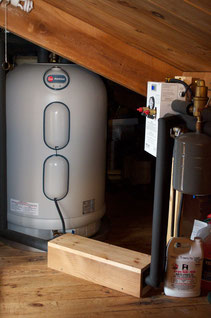
The 'Marathon' brand 50 gallon hot water storage tank for the solar water heater.

The 'SunPower' brand
Signature™ black solar panels are matched with a 'Sun Power' inverter.
Energy Efficient Cooling and Heating
When moving to New Hampshire in 1974, we never thought we would ever need an air conditioner. We would typically have one or two 90℉+ days in a summer. But that has changed. Fast forward twenty years - in 2000 we had 20 days that were over 90℉. And in 2010 we experienced 30 90℉+ days!
Because of the new norm of hot summers we decided to install a fairly new heating and cooling technology available for cold climates, a mini-split heat pump.

The inside wall fan unit for our Mitsubishi Mini-split heat pump.

The outdoor condenser unit for our Mitsubishi Mini-split heat pump.
Our Mitsubishi Mini-split heat pump is highly efficient and can be used for both air conditioning and heating.
Distant Hill was listed as one of the Top 10 Places to Visit in New Hampshire!
Friends of Distant Hill (dba Distant Hill Gardens and Nature Trail) is a nonprofit,
tax-exempt organization under Section 501(c)(3) of the U.S. Internal Revenue Code.
Donations are tax-deductible as allowed by law. Tax ID# 84-3765898
or send a check via Snail Mail to:
Distant Hill Gardens and Nature Trail, 507 March Hill Road, Walpole, NH 03608

